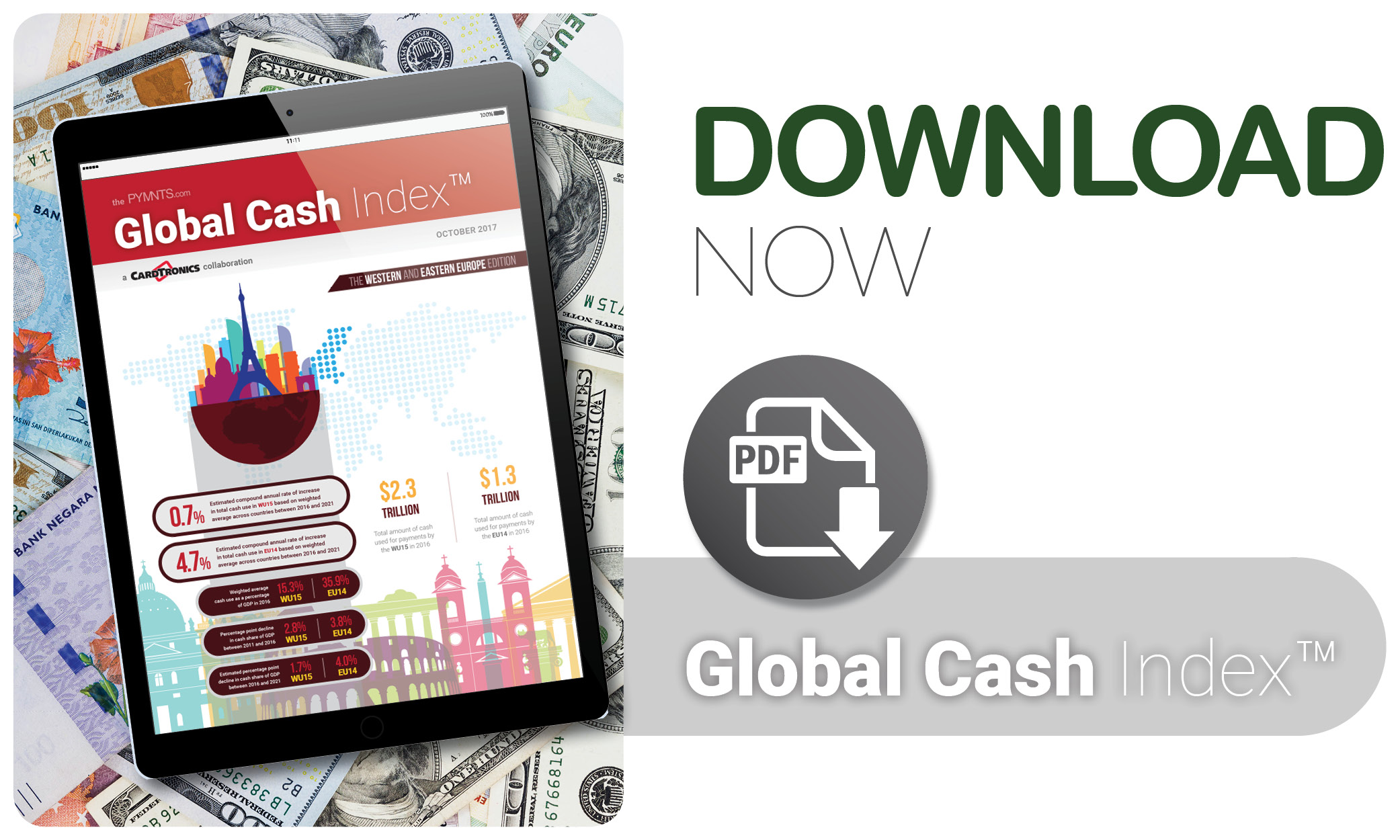When It Comes To Payments, EU Consumers Would Rather Pick Cash

Be it Western or Eastern Europe, when it comes to paying for daily transactions, consumers still pick cash — $3.6 trillion of the cold, hard stuff was spent in 2016, according to the latest PYMNTS.com Global Cash Index™ Western and Eastern Europe Analysis. But with digital and contactless payments making in-roads, will cash survive? ATMIA’s Director Ron Delnevo says cash will persevere — with some growing pains — much like the brick-and-mortar stores in the age of internet retailing.
Despite the growing availability of and interest in digital and contactless payments, when it comes to consumer preference, cash continues to be the ultimate show stopper.
Nearly 75 percent of point-of-sale transactions in the European Union (EU) today are paid using cash, according to a recent European Central Bank study, which surveyed more than 65,000 consumers in 17 countries. While there is an overall increase in circulation of cash, each of the member states in the EU has a varying affinity for it.
PYMNTS recently caught up with Ron Delnevo, director of the ATM Industry Association (ATMIA), to discuss European cash use and touch upon some of the emerging payment trends in the U.K. – many of which may prove to be the bellwether for use of differing payment methods across Europe.
While cash may be losing some of its share in certain markets, Delnevo said, overall use of cash in Europe is continuing to increase at a healthy rate, and will likely be in the driver’s seat for years to come.
Cash and Its Changing Accessibility
With growth in online banking in the EU, foot traffic to bank branches has steadily declined over the last few years.
Some 9,100 bank branches were shuttered in 2016 alone, a 4.6 percent decline on the previous year, according to the European Banking Federation. And, with that, access to cash-dispensing ATMs has steadily decreased as well.
Additionally, the number of ATMs installed across Europe has reportedly been declining by 6 percent every year since 2010.
“This is starting to cause problems – not so much for the accessibility and withdrawal of cash, but certainly [for] the ability to deposit cash,” Delnevo said, adding that consumers in smaller towns must increasingly make long trips to deposit cash.
“Catterick, Yorkshire, for example, is a town of nearly 3,000 inhabitants, a race course, an army barracks, shops and swans, [but has] no bank branch or post office,” he said. “So, if you want to deposit cash, you have to go to Richmond, a few miles away, to find an ATM that accepts cash.”
While the shift toward digital banking has contributed to a decline in bank branches and ATM machines, it hasn’t made a severe impact on use of cash. With the closure of bank ATMs, third-party ATM companies are quickly expanding their footprints to fill the void, Delnevo added.
Banks often take a conservative position when it comes to cash and have a mindset that cash and ATMs aren’t going to be around for too long, he explained, so why should those financial institutions feel compelled to invest much money?
Instead of hoping for consumers’ need for cash to go away, though, banks must understand market demand and focus on developing innovative ATMs that not only recycle cash, but also hold the potential for replacing bank branches, Delnevo said.
Cash’s Fight with Contactless Payments
Contactless payments have come a long way since their U.K. introduction 10 years ago. Today, in fact, U.K. consumers can tap-and-go to board the London Underground and spend up to £30 via contactless payments. With that, overall use of contactless payments has quickly skyrocketed.
By the end of 2016, nearly 27 percent of card-based payments were contactless, a 15 percent increase from the year before, according to the UK Cards Association.
And, while contactless payments seem to have taken a sizeable bite out of chip- and PIN-based transactions, they are still an underdog when compared to cash – at least in the retail setting.
Nearly 76 percent of transactions made at approximately 50,000 convenience store locations in the U.K. are still made using cash, according to a 2017 report by the Association of Convenience Stores.
“That’s despite the fact that we have [had] contactless in the U.K. longer than any other European country, but cash is still something that many people trust,” Delnevo said. In addition, most mom-and-pop stores in the U.K. are contactless-enabled.
Although Delnevo foresees an increase in the use of contactless payments, even at such mom-and-pop stores, he believes it’s unlikely to gain significant traction in the near future, even if the £30 limit were to be increased to a £100. If anything, he sees an increase in the limit as a possible deterrent in contactless payments growth.
“Contactless wasn’t invented for £100 transactions,” Delnevo said. “Making that too high would have big security implications. Increasing it to £100 makes it very worthwhile to steal someone’s card for seven or 10 transactions. All of [a] sudden, that’s not minor theft anymore.”
That stands true for any country in the European Union, Delnevo said.
Growth in Circulation
Despite the ever-growing competition, overall use of cash keeps increasing. In 2016, the U.K.’s overall use of cash hit £70 billion, an increase of 10 percent, marking its fastest growth in a decade, according to the Bank of England.
Meanwhile, cash’s circulation in Western European countries continues to remain very high, especially in Austria, Germany, Italy, Slovakia, Spain and Portugal, Delnevo pointed out. In fact, even among countries that have seen cash use decrease, there’s little interest in steering away from it completely.
“I have met with central banks in Sweden, Denmark and Norway – [none] want to go cashless,” Delnevo said. “They see advantages with cash as a financially inclusive medium, as an educational medium and as a store of value.”
Ultimately, as alternate payment options see growth in usage, consumers are bound to adopt a variety of payment methods.
“You don’t want too much centralized power,” Delnevo explained. “Let’s have payment choices: WePay, Alipay, Apple Pay, Samsung Pay – we need choices, and there’s still room for all of them.”
Delnevo sees growth of payment methods much the same as the evolution of the modern transportation system. Consumers can pick and choose between walking, flying, boating or riding a train, among other options, and all options can coexist.
“That’s the way it should be in payments,” he said. “It’s too important to become thin and narrow.”
And, with cash sharing its place with other payment methods, it seems consumers and small businesses remain far from the idea of trading it in for digital payment methods.
To download the PYMNTS.com Global Cash Index™ Western and Eastern Europe Analysis, please click below…
About the Index
The PYMNTS.com Global Cash Index™, a Cardtronics collaboration, focuses on the use of cash for making payments and as a payment method that equally plays a role with cards, checks, direct debit and other methods of settling up between consumers and businesses. Unlike most reported estimates of cash, our proprietary data analysis focuses on the use of cash for making payments rather than hoarding.

